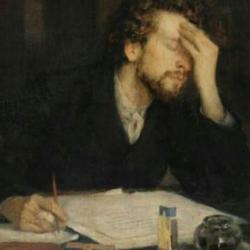INTRODUCTION
For Elizabethans, Rome was not only an ancient power but a very real contemporary power. The plays of Shakespeare that are set in Rome and those derived from Roman models often work in both registers, bringing papal Rome into plays set in ancient times. I will look at some of the contemporary allusions in Comedy of Errors , and examine Shakespeare?s views on ancient Roman piety in my discussion of Titus Andronicus .
COMEDY OF ERRORS
Shakespeare?s Comedy of Errors was based on a play by the Roman playwright Plautus entitled Menaechmi (Twin Brothers). Shakespeare made a number of changes in the story (e.g., he gave the twin brothers slaves who were also twin brothers), but the basic story-line and comic tone remain.
Despite its farcical and slapstick plot, Shakespeare shaped the Comedy of Errors to raise issues that go beyond sheer comedy. First, the title, ?Comedy of Errors?Econtains a Latinized pun; the play is full of errors in our sense of the term, especially errors of mistaken identity. In Latin, errare means ?to wander,?Eand the play is about wandering as much as it is about errors. As the characters stumble through life, moving from mistake to mistake, things eventually turn out well.
Second, Shakespeare added some darker shadows to the setting of the play. The play begins with Egeon, father of the two Antipholuses, condemned to death for coming to Ephesus (1.1.1-25), and the sentence cannot be set aside (1.1.140-155). Nor is this the first tragedy for Egeon, as he explains to Duke Solinus of Ephesus (1.1.31ff). The marriage of Antipholus and Adriana is threatened, there are repeated beatings, and Antipholus of Syracuse eventually is judged mad. Much of this is played for laughs, but the tragic potential of the situation is evident. In the end, this tragic coloration makes the final reconciliation deeper and more satisfying, albeit it takes place in a flash.
Third, at several points Shakespeare alludes to Papal Rome and its practices. Dromio calls for his ?beads?Eand says he makes the sign of the cross (2.2.187-88), and there is a reference to confession (4.4.55-58) and sanctuary. The repeated claim that Ephesus is a place of magic and supernatural events associates the city with the exotic practices of Rome (1.2.97-102; 2.2.188, 194).
The clearest example of the presence of Papal Rome in this play is the Abbey and the Abbess. Antipholus and Dromio of Syracuse escape to the Abbey, where the sturdy Abbess rebukes Adriana for pestering her husband to madness (5.1.68ff) and promises to nurse him back to health with ?wholesome syrups, drugs, and holy prayers?E(5.1.102ff). Some critics have suggested that by introducing an Abbess as such a strong and sympathetic character, Shakespeare was hinting at his preference for Catholicism. The Abbess, after all, brings a final resolution to the wandering/errors by presenting Antipholus of Syracuse (5.1.331). Perhaps Shakespeare believed that reintroducing Roman institutions and practices, and especially reintroducing a strong feminine element, would save England from her post-Reformation confusions.
I think not. The Abbess is a mother and wife, who will doubtless leave the Abbey and return to Egeon, whom she speaks of as ?my husband?E(5.1.405). Further, the recovery of her sons ends thirty-three years (!) of travail/labor (5.1.395ff). She is perhaps a Marian figure (the play was first produced during Christmas, and cf. 5.1.408), but she seems more to represent the church than any particular Roman institutions.
VENGEANCE
Titus Andronicus is, I?ve suggested, a typical Elizabethan Roman play, full of bloody, violence, mayhem, and political struggle. It is not, however, concerned with any particular historical period of Roman history. Shakespeare drew motifs from Ovid?s Metamorphoses and a ?History?Eof Titus Andronicus.
Titus is a revenge tragedy, and as with most other revenge tragedies, it depicts the horrific consequences of the code of vengeance. Once vengeance is unleashed, there are two outcomes (or some combination): Either every relevant person is butchered and bleeding ( Hamlet , Titus ) or the system of vengeance is replaced with some legal mechanism for resolving disputes peacefully (Aeschylus?EOresteian Trilogy). Titus gives a combination of these two outcomes. On the one hand, there is a nauseating sequence of mutilations, murders, and assorted acts of violence. One critic offers this tabulation: ?E4 killings, 9 of them on stage, 6 severed members, 1 rape (or 2 or 3, depending on how you count), 1 live burial, 1 case of insanity and 1 of cannibalism ?Ean average of 5.2 atrocities per act, or one for every 97 lines.?E On the other hand, the play ends with the exiled Lucius gaining the throne and ridding Rome of ?tigers.?E
The point is underscored by the symmetry of the play, as events and characters find mirrors in other events and characters. Titus kills Alarbus, Tamora?s son; in retribution, Tamora arranges for the deaths of Titus?Etwo sons, Quintus and Martius, the rape of Lavinia, and the banishment of Lucius; the retribution doubles back when Titus kills Tamora?s two remaining sons, Demetrius and Chiron, and feeds them to her for dinner. There are two other sets of brothers: Saturninus and Bassianus quarrel over the imperial throne, and Titus is comforted by his brother Marcus. Titus?Esons are in coffins in Acts 1; in Act 5, Titus makes a ?coffin?Efor Tamora?s sons. The parallels between1.1 and 3.1 are a good example of the play?s patterns: In both, a parent pleads for the life of son(s), only to be ignored.
It is also characteristic of Shakespeare?s tragedies that the tragic protagonist?s sufferings far exceed the wrongs that he does. Bad things happen because the characters sin, but in various ways the consequences of the sin escape everyone?s control. Macbeth is a murderer, and after he murders Duncan he cannot stop the flow of blood. King Lear errs in abdicating his throne, but his suffering seems terrifically disproportionate to his crime. Titus is unflinchingly cruel in his treatment of the Goths, but Tamora?s wrath and revenge seem boundless. It is no accident that she presents herself as the personification of vengeance in 5.2.
CRUEL PIETY
So much for Titus Andronicus as tragedy. What does it say about Rome? The play does not belong to any identifiable period of Roman history. Every form of Roman political life is represented: There is an emperor, though the position is not hereditary, and there are elements of the Republican form of government. The Romans are fighting Goths, which would place the story sometime in the 4th-6th century AD. It appears that the play intends to represent an ideal ?Rome,?Ethat is, to include every period of Roman history. The play presents the essence of Rome. The tone is oddly comic, with lots of wordplay, even at the most gruesome moments (e.g., 4.2).
Shakespeare?s particular interest is in the Roman code of honor and piety that drives the events of the play. Titus?Ehonorific name is ?Pius,?Ea pointer to one of the basic Roman ethical principles, pietas. Pietas was the virtue displayed by Aeneas, Rome?s Trojan founder, and it encompasses honor to the gods, loyalty to family, and devotion to the city; perhaps the best English translation of ?pius?Ewould be ?responsible.?E
Pietas is truly a virtue, but in Titus it takes a horrifying form. Out of piety, Titus sacrifices Tamora?s son Alarbus to his own dead sons. This is the first act of violence, and unleashes the remaining violence. Savage as she herself is, Tamora captures the flavor of Roman piety, which she describes as ?cruel, irreligious piety.?E Even Titus comes to recognize the character of Rome. When the tribunes refuse to hear his appeal for his condemned sons (framed by Tamora and Aaron for the murder of the emperor
?s son), he concludes that ?Rome is but a wilderness of tigers,?Efull of predators whose only prey is ?me and mine?E(3.1.52ff). As Shakespeare depicts it, this cruelty and bestial savagery is not a contradiction of Roman honor and piety, but a direct result of that code. Perhaps he had been reading Augustine, who said that Rome?s virtues were nothing but ?splendid vices.?E Some of the most brutal acts seem all the more inhuman because they are so carefully ceremonialized, and by the stark contrast between the ceremonial violence and the sentiments expressed by the characters (like the sacrifice of Alarbus in 1.1, followed by Titus?Ewords at his sons?Eburial).
The violence of the play becomes a potent political symbol. Early in the play, Saturninus and Bassianus vie for the imperial throne, and Marcus describes this as a process that will ?set a head on headless Rome?E(1.1.189). Titus refuses to stand as a candidate: ?A better head her glorious body fits than his that shakes for age and feebleness?E(1.1.190-191). Because Rome receives a vicious head like Saturninus, a head whose head is turned by the Gothic tigress, the whole body is wracked and dislimbed. Politically, though, the play ends (like Macbeth) with the restoration of legitimate and orderly governance. Lucius returns with the ?barbarian?EGoths, who turn out to be more civilized than the Romans. Lucius displays his wounded body as evidence of his devotion to Rome (5.3.96ff), and Marcus proclaims that Lucius?Erule gives Rome a chance for renewal: ?O, let me teach you how to knot again this scattered corn into one mutual sheaf, these broken limbs against into one body?E(5.3.67ff).











